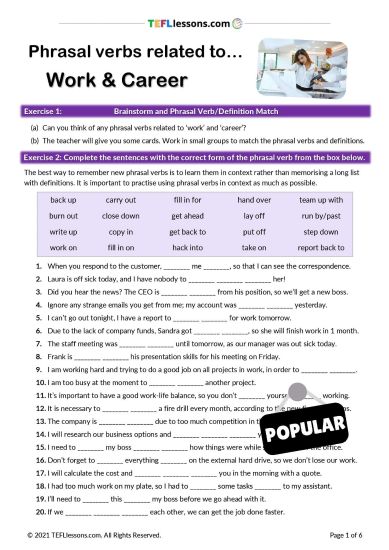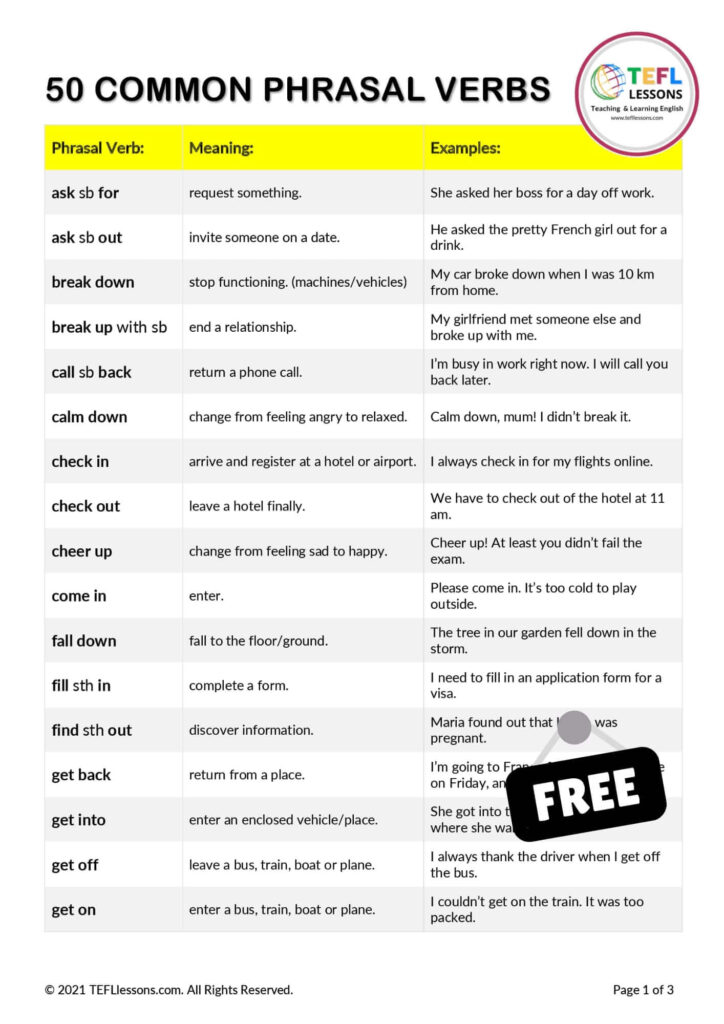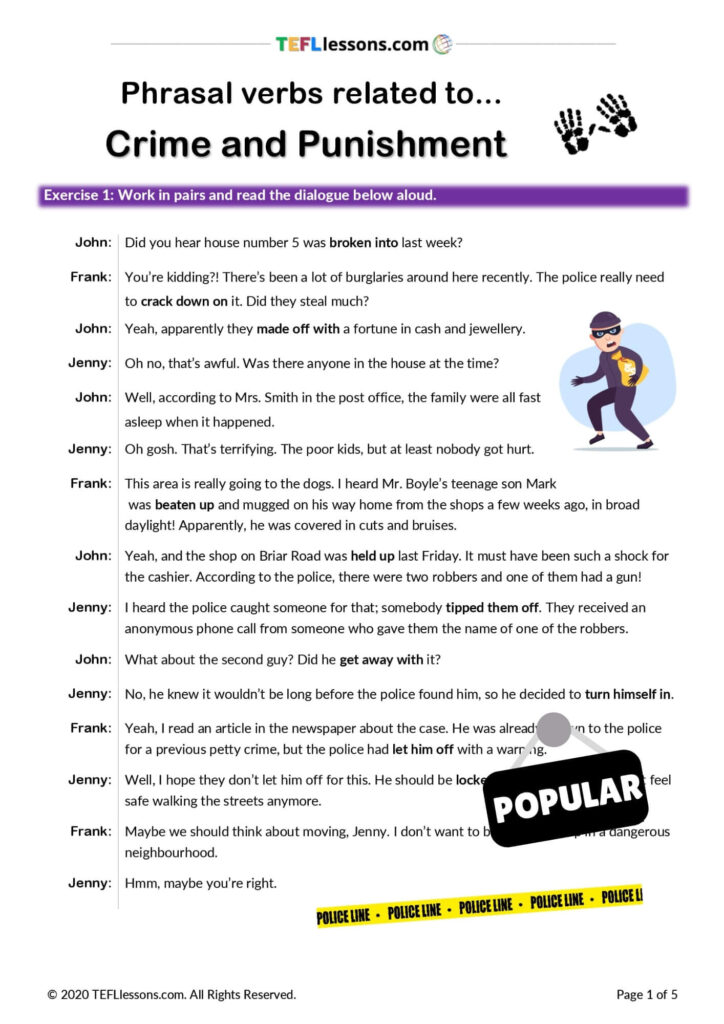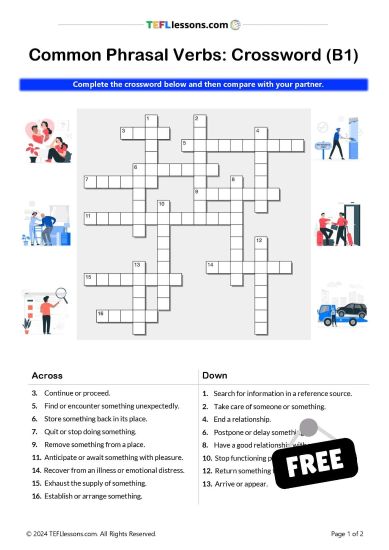This guest article was written by TEFL Lessons, a lesson plan provider with free and subscription-based ready-made ESL teaching materials.
The ability to understand and use phrasal verbs is essential for fluency, comprehension, vocabulary expansion, and cultural integration in English-speaking environments. However, TEFL teachers often struggle to explain them, and students find them difficult to grasp or recall. Read on to discover why phrasal verbs are so challenging, get strategies for how to teach phrasal verbs to ESL learners, and download some phrasal verb lesson plans for ESL teachers, which will make teaching phrasal verbs a breeze!
If you’re a new TEFL teacher, you might first benefit from familiarising yourself with the basic rules for phrasal verbs. Learn more about phrasal verb rules.
Why are phrasal verbs difficult to teach?
There are many reasons phrasal verbs can be difficult to teach and learn. From idiomatic meanings to translation difficulties, there are a variety of challenges to overcome for both the teacher and learner. Here are some of the reasons phrasal verbs are challenging.
- Translation Issues: Phrasal verbs often lack direct equivalents in other languages, making them challenging for learners who rely on translating directly from their native language.
- Similarities: It is easy to confuse several phrasal verbs, as many use the same verb, but the meaning changes depending on the particle; for example, take on, take off, take over, take up, and take away.
- Multiple Meanings: Phrasal verbs frequently have multiple meanings. For instance, take off can mean to remove clothing, depart or leave (airplanes), suddenly become successful or popular, and mimic or imitate someone or something. It’s no wonder that students find this challenging!
- Idiomatic Meanings: Several phrasal verbs have idiomatic meanings that cannot be deduced from the individual words. For instance, the phrasal verb make up means to become friends again after an argument, but the meaning is not obvious from the individual words.
- Overload: English has a vast number of phrasal verbs, and learning them all can feel overwhelming.
How to teach phrasal verbs to ESL learners: 11 effective strategies and resources
1. Stress the importance of learning and using phrasal verbs.
Phrasal verbs are a fundamental component of the English language and are used extensively in daily conversation, as well as in literature, newspapers, magazines, and online content. No doubt you have encountered or will encounter students who insist on sticking to alternative verbs. While this strategy may allow them to say what they wish to some extent, it’s important to remind them that it won’t help when it comes to comprehension. There is also a misconception that phrasal verbs are only used in informal settings. While it is true that they are more common in informal English, they can also be used in formal settings. There are, for example, several phrasal verbs that are used in business- and work-related English.
- Resource: The following phrasal verb lesson plan focuses on work-and-career-related phrasal verbs. Download the lesson plan here: Phrasal Verbs Related to Work & Career.

2. Introduce phrasal verbs to lower-level students with the use of visual aids.
Basic phrasal verbs such as get up and sit down can and should be introduced to lower-level students. Using visual aids such as pictures, diagrams, videos, or gestures can be particularly useful when illustrating the meaning of phrasal verbs to lower-level students.
- Resources: The following handout (free) and basic phrasal verbs lesson plans (pay to download) all utilize images for introducing the grammar rules for using phrasal verbs. Download them here: 50 Common Phrasal Verbs, Basic Phrasal Verbs (1), and Basic Phrasal Verbs (2).

3. Introduce phrasal verbs based on certain themes.
Examples of themes for introducing phrasal verbs include emotions, work, travel, and so on. This method helps learners organize and categorize the verbs, making them easier to remember and use correctly.
- Resource: The following free resource focuses on phrasal verbs related to holidays and travel. Download the lesson plan: Phrasal Verbs Related to Holiday and Travel.

4. Provide examples in context.
By encountering phrasal verbs in meaningful contexts, students are more likely to remember them and use them appropriately. Materials that include phrasal verbs used in context, such as dialogues, listening comprehension exercises, and reading texts, are all helpful. You should encourage learners to guess the meaning of each phrasal verb based on context clues or familiar words. Authentic materials such as movie clips, songs, news articles, and podcasts that feature phrasal verbs are also great options for providing context for higher-level students.
5. Use a variety of exercises when teaching a set of phrasal verbs.
In addition to facilitating understanding, using a variety of exercises provides the repetition required to help your students memorize phrasal verbs. You could start by asking the students to try to guess the meaning of phrasal verbs highlighted in a reading text or dialogue; next, they might match these same phrasal verbs to definitions provided; then, they could do an exercise where they need to fill in the gaps in sentences with the correct phrasal verb or the correct particle.
- Resource: For a phrasal verb lesson plan that follows the above pattern, check out the following resource: Phrasal Verbs Related to Crime and Punishment.

6. Provide lots of opportunities for practice and production.
It’s essential that once students have been introduced to a set of phrasal verbs, they are given sufficient time to practice them in a variety of ways. This might include speaking tasks like role-playing activities that simulate real-life situations where phrasal verbs are commonly used or conversation questions that feature phrasal verbs. Written practice might include simple sentence creation or writing a dialogue or paragraph that incorporates a given set of phrasal verbs. Practice activities that relate to the students’ own experiences, interests, or goals are especially useful, as personalization makes the learning process relevant and more meaningful.
7. Utilize games, puzzles, and quizzes.
In addition to the practice exercises mentioned above, charades, crossword puzzles, word searches, and quizzes are all excellent ways to practice and review phrasal verbs while bringing an element of fun into the classroom.
- Resources: Check out the following phrasal verb games and puzzles: Common Phrasal Verbs Crossword (B1), Phrasal Verbs (Act or Explain), and Phrasal Verbs Board Game.

8. Spend sufficient time focusing on use when you encounter a new phrasal verb.
When you come across a new phrasal verb in the course of a lesson, it is not enough to simply provide a definition. You should always model a few examples that demonstrate appropriate usage and make the students aware of the grammar rules. E.g., Is it a separable or inseparable phrasal verb? Is it transitive or intransitive?
9. Don’t overwhelm your students by introducing too many phrasal verbs at once.
In general, around 5-10 phrasal verbs per lesson for beginners or elementary students is plenty. At higher levels, you can increase the quantity, but always make sure that you are providing ample opportunities for practice, reinforcement, and review.
10. Make time in class for error correction.
This is particularly important at lower levels. Common errors include separating an inseparable phrasal verb, confusing phrasal verbs that have the same main verb but different particles, and using a phrasal verb in an inappropriate context. In order to help students overcome these errors, you should use on-the-spot correction during writing and speaking activities. It’s also helpful to make a note of errors the students make during a class activity. You can transfer any sentences containing errors to the board, and then have students discuss each sentence in pairs and try to identify the errors. Finally, elicit students’ ideas before highlighting errors and explaining correct usage with examples in context to reinforce learning.
11. Encourage learning and reflection outside of class.
Reading, watching films or TV series, and listening to podcasts in English will allow your students to encounter phrasal verbs in natural contexts. Suggest that your students keep a notebook, where they can record any phrasal verbs they come across inside or outside of the classroom, along with their meanings, contexts, and example sentences. Finally, recommend using phrasal verb apps for extra practice.
At TEFLlessons.com, you can access a plethora of useful phrasal verb lesson plans and worksheets. Register for a free account to download more than 100 free resources!




